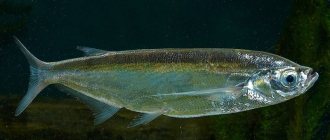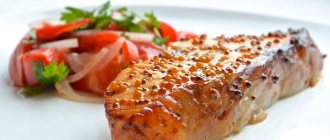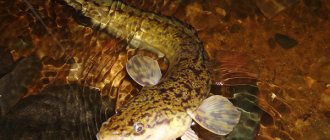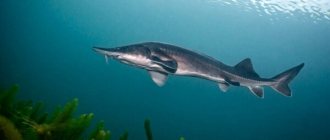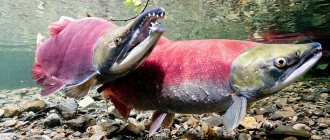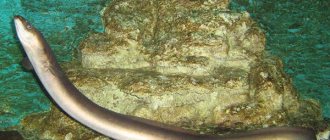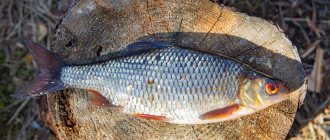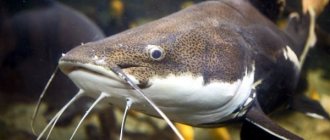Description of silver bream fish
According to the scientific classification, the silver bream is a ray-finned fish from the carp family, the only representative of its genus. In Ukraine it is called “weasel”, in Belarus - “gustyara”, near Ryazan “lopyr”, in the Lower and Middle Volga - “tarashka”.
And people from other regions of Russia are accustomed to hearing the “names” “ploskushka”, “Kalinka” or “Terekha”.
Appearance of fish
The description of the silver bream resembles the appearance of a white bream, the body is just as flat and laterally flattened. The nose is blunt, the head is small, and on the back of the head there is a groove of skin not covered with scales.
This is where the similarities end, and the differences begin, which are seen mainly only by experienced fishermen.
| Gustera | Podleschik |
| The teeth in the pharynx are arranged in 7 pieces on both sides in two rows | Single row, 5 teeth left and right |
| Eyes - with huge pupils, looking straight | Small, slightly tilted down |
| The lower and pectoral fins are reddish or orange in color | Dark gray, almost black |
| The anal and dorsal fins have 8 and 24 rays, respectively. | 9 and 29 |
| Number of scales along the lateral line: 44–47 pieces | 51–57 |
| Scales – large and gray, on the back with a bluish tint | Bone plates are small, bronze-tinged, covered with mucus |
The color of the white bream's body changes depending on age, season and local conditions.
Unlike the bream, a strongly convex back rises like a hump against the background of its small head. This sign becomes noticeable in mature fish, starting from the first spawning.
The main differences between the silver bream and the white bream
The main differences between the silver bream and its closest relative, the white bream, are such as the location and number of pharyngeal teeth, seven instead of five like the white bream and bream, and they are arranged in two rows. The body shape of this fish is similar to the bream, but the number of rays in the dorsal fin is smaller, 3 simple and 8 branched, and there are also fewer rays in the anal fin, 3 simple and 20-24 branched rays.
The scales of the silver bream are much larger and on the back, too, in contrast to the scales of the bream. The paired fins are reddish or red in color, in contrast to the color of the bream's fins.
Fish sizes
The maximum dimensions of the silver bream (linear and weight growth) are 35 cm and 1.2 kg. Compared to bream, it is a skinny and bony fish. The height of the body is ⅓ of the entire length - from the top of the snout to the end of the scaly cover.
The largest specimens are mainly caught in Lake Ladoga and the Gulf of Finland. In reservoirs of other regions, the average weight does not exceed 400 g, less often it is 600–800 g, with a length of 30 cm.
Lifestyle
The sedentary silver bream prefers the warm waters of bays and reaches, rivers with quiet currents and holes with a muddy or sandy-clay bottom.
Juveniles swim near the shore among algae and river vegetation, and large fish stay at a depth of 5–9 meters.
It indicates its presence in a pond with garlands of air bubbles floating on the water surface.
- On quiet summer nights, the silver bream often rises to the surface, splashes and tumbles on the moonlit path.
- In autumn and spring it gathers in dense flocks so that there is nowhere to insert an oar. This is the time when fish go to their wintering or spawning grounds.
- In the cold months, it lies under rocks at the bottom, from where fishermen pull it out.
Distribution and habitats
The silver bream is widespread in Europe east of the Pyrenees and north of the Alps and Balkans. Inhabits rivers and lakes in the basins of the North, Baltic, Black, Azov and Caspian seas. From the White Sea basin, the silver bream is recorded in the lakes of the Onega and Northern Dvina river basins, and is rare in the Northern Dvina itself and its tributaries.
Distribution map of silver bream
The silver bream is considered a lazy and sluggish fish, and therefore, like bream, it loves quieter, deeper, warmer water with a silty or clayey bottom. Therefore, often, silver bream and bream can be found in the same body of water. It can be found everywhere, both in shallow water and in a hole, both in a fleeting stream and a backwater, both in thickets of grass and far from them, on both hard and soft ground. The silver bream lives in the same place for a long time, and most of all it loves to be near the very shores, especially in strong winds, since the waves during the surf erode the shores and give the silver bream the opportunity to find food for itself.
Nutrition
The silver bream finds food in soft soil, among thickets of underwater plants and in algae. Juveniles eat zooplankton, and the nutrition of mature fish depends on the season:
- In spring these are worms, maggots, and rudd caviar.
- In summer - insect larvae (mosquitoes, caddisflies and dragonflies), small mollusks.
At the end of summer, when there is less food in the reservoir, the silver bream swallows the fry.
Diet and nutrition of silver bream
The silver bream feeds on bloodworms, caddis flies, and crustaceans. Older representatives consume larger insects. The main places in which the medium-sized silver bream looks for food are the coastal zone and places with snags. Larger individuals prefer to feed in areas distant from the shore. You can catch them in summer and autumn with a feeder or donka. Fishing for silver bream with such gear is most effective.
An interesting detail was noted in the feeding habits of the silver bream. In the coastal zone they eat insect larvae, and in deeper places they feed on crustaceans.
Reproduction of silver bream
The silver bream begins to reproduce in the first year of life. The female at this time is on average 12–14 cm long and can lay up to 100 thousand eggs per season. The grains come out in portions, 2–3 times with an interval of 10–15 days.
With the help of sticky mucus they stick to bottom plants. And after a week, transparent fry with suckers instead of mouths develop from them.
White bream fishing calendar
| January | February | March | April | May | June | July | August | September | October | November | December |
| + | + | ++ | +++ | +++ | +++ | +++ | +++ | ++ | ++ | + | + |
Finding a fishing spot
If a fisherman sets out to catch as many silver bream as possible, it is better to go to the lake or to the flat area of the river. Most fishermen catch silver breams in open areas of reservoirs.
In windy weather, the silver bream swims close to the shore. It feeds on worms and insect larvae. The wind washes worms and larvae that have fallen into the water to the shore, and the silver bream hurries to feed.
An experienced fisherman will detect a feeding school very quickly, due to a chain of water bubbles, which is clearly visible on the surface of a lake or river. This fish is incredibly punctual; feeding is a serious matter for it. Each flock comes to feed at a certain time, the fish always goes to the place along the same route, feeding at one point for several hours.
She prefers a mixed diet, she likes algae, but most of all - zooplankton, large mollusks, worms, and larvae. Sometimes it may seem that the silver bream is feeding all day. This is not so, flocks in one place simply replace each other.
The last feeding of the silver bream lasts from one and a half to two and a half hours, ending an hour before sunset. At dusk, fish can hardly be found near the shore. In addition, she does not like rocky, loamy, or muddy places.
Reaches sexual maturity at the age of 3-4 years with a length of 11-15 cm. Males usually mature 1-2 years earlier than females and at a smaller size. During spawning, the males' head and sides of the body are covered with whitish epithelial tubercles, and the paired fins become reddish. Females spawn 2-3 portions of eggs with an interval of 10-15 days. In reservoirs, the number of servings is smaller, and some females switch to one-time spawning. Spawning of silver bream occurs in late May - early June at a water temperature of 15-17°C and lasts 1-1.5 months. Spawning is noisy and occurs at night. The eggs are sticky, deposited on flooded vegetation, washed out plant roots at a depth of 20-60 cm. Fertility - 11-109 thousand eggs. The development of eggs lasts 4-6 days. The larvae attach to aquatic vegetation before resorption of the yolk sac. Juveniles first feed on phyto- and zooplankton, then on small benthic forms.
The silver bream lives in areas of reservoirs with slow flows or standing water. One-year-old and 2-year-old individuals live in schools (often with juvenile bream) in thickets of plants in places with a silted bottom, quickly warming water and an abundance of food. The larger silver bream colonizes greater depths of water bodies.
Important! The last feeding of the silver bream lasts from one and a half to two and a half hours, ending an hour before sunset. At dusk, fish can hardly be found near the shore. In addition, she does not like rocky, loamy, or muddy places.
Spawning
The beginning of spawning of silver bream occurs at the end of May or beginning of June. Then large and small fish gather in separate schools. The instinct of reproduction causes their migration, the path of which lies in the grassy bays.
During this period, the color of the body changes, and the red paired fins become brighter.
- Males develop granular tubercles during spawning.
- In the photo of the silver bream they can be seen along the edges of the scales and on the gill covers.
- Small fish spawn earlier, and large fish later, at a water temperature of plus 17–18 degrees.
- This phenomenon occurs after sunset until sunrise and occurs with a fair amount of splashing and noise.
Lifespan
In nature, the silver bream lives for 10+ years and matures in 3–4 years or earlier. At this age, it reaches a length of 8–10 cm or 12–14 cm, depending on its habitat, and its weight is 15–20 g.
Life expectancy, growth and development are influenced by environmental conditions. This period is shortened by spinners and floaters by organizing mass catches during spawning.
Methods for catching silver bream
White bream can be caught all year round, with the exception of periods of flooding and the formation and destruction of ice. The best bite begins at the time when the bird cherry blossoms, the jasmine blooms and the apricots begin to swell. What equipment and baits to use when fishing depends on the season.
Fishing in spring
At this time of year, when spring is only on the calendar in cold regions, the main method of catching silver bream is by vertical trolling. In March, fish bite at the mouths of streams and rivers, when the ice begins to thaw and edges appear. It rises from the pits where it hibernated and swims behind underwater spits, near the shore, at the border of the current and standing water.
- Although the main fishing occurs in autumn and summer, the largest silver bream is still caught before spawning.
- Fishing with it is fast, one might say sporty, but short-lived.
- Continues until the water warms up to 16–17 degrees.
At the end of May, bottom and float fishing rods are used, as well as live bait - pieces of worms and bloodworms.
Fishing in summer
Somewhere, silver bream is caught on a piece of salted herring, and in Germany they use crumbs with honey. It itself is considered the best bait for catching pike, large perch and catfish.
When biting, the fish drags the line to the side, but does not submerge the float. They catch it from a boat with a winter fishing rod with a jig and a nod or a spinning rod.
Special equipment is better suited for this purpose:
- Line with a diameter of 0.2 mm.
- Hooks with a short shank numbered 4 and 5.
- Long thin float (material – hard foam).
The time to hook a fish comes at the moment when the nod rises up or bends down. Large specimens are caught near the coastal edge, at the outlet of an underwater ditch or in deep places at river mouths. Only there does the silver bream find aquatic worms and river mollusks of the zebra mussel, which it feeds on in the summer.
Fishing in autumn
Big catches are always expected in the lower reaches of rivers, where the fish move for the winter. The beginning of autumn is the period when the silver bream is attacked by zhor.
She strives to stock up on nutrients, and therefore actively bites on all baits:
- Bloodworm;
- Maggot;
- Muckworm;
- Malek;
- Caddisfly.
In autumn, when the water cools, fish swim and feed in the depths. And therefore it is caught only with bottom fishing rods, from the shore or from a boat.
Fishing in winter
Catching silver bream in winter is complicated by the fact that the water in the ice hole is clear, and therefore only thin tackle is suitable. At this time of year they catch with bait for 2+ days, at night, with a net, with a jig or a fishing rod with a float. They use bait: bloodworms, worms.
At the moment of biting, the fish first pulls the float, and then slightly drowns it or lifts it. The best place for the winter bite is the dumps and bays where there is a lot of shell rock.
Why do you love the silver bream?
Today, many fishermen treat this fish very disdainfully. But in vain, Gustera is not a bream, not an ide, and not even a podust, for the sake of catching which you can strain yourself, setting up tackle and selecting baits and bait. For most feeder fans, silver bream is bycatch. Often unwanted. She quickly reacts to bait and manages to deal with it long before the larger fish approaches. The most popular river baits, worms and maggots, also suffer from raids by silver breams. Neither bream nor ide want to take a dented bait. So why do you love the silver bream? But this is what those who have never held a silver bream weighing “under a kilogram” say on a fishing rod. But those who are lucky enough will agree that it makes sense to hunt for a large specimen of this fish.
Finding small white bream weighing up to 100 g in the river is not a problem. Together with roach of the same size, it lives in large numbers along thickets of coastal grass or in river flows with a slow flow. But the weighty silver bream is not found everywhere. In large rivers, it selects areas with great depth and strong currents. Less commonly, large silver bream enters medium-sized rivers. And it almost never appears in small rivers. Here it can be found only during the spring flood immediately before spawning. This is primarily due to the feeding nature of the silver bream. Unlike bream, which loves to feast on bloodworms and therefore often appears in shallow silted areas, large silver bream feeds on zebra mussel and aquatic worms, which do not live on the muddy bottom. In addition, in search of food, this large fish constantly migrates, which is very similar in behavior to large river perch. As with large perch, chasing a silver bream along the river is practically useless. The most effective way is to wait for her in the right place at the right time. We’ll talk about the points where it’s easiest to find silver bream below. But regarding the best time for its biting, I will say this: there are several periods in the year when hunting for large silver bream is most effective. The first time this happens is in May-June, when the silver bream goes to spawn. The second time it becomes easily accessible to anglers is at the end of August. The August move of the silver bream is less noticeable, so most fishermen are not even aware of it. The June run of the silver bream is good because you can not only find fish relatively easily, but also adapt to the fishing conditions.
Period, period, comma...
Like any other fish, the large silver bream has its own points where it feeds, rests and gives birth. And in order to be with the catch, the fisherman simply needs to know her life schedule.
The pre-spawning run of the silver bream begins quite early - approximately in the second half of April. It always somewhat resembles the spring “flushing” of roach, but the silver bream never rises as high as roach or ide. And it doesn’t go out to warm itself up. Even in spring, depth is very critical for it. According to my observations, the minimum depth at which a large silver bream can be found in the river at the beginning of summer is approximately 3 meters. And just a week after spawning, which for the silver bream occurs in grassy shallow waters at a water temperature of 16-18 degrees, large specimens roll back into the river bed and almost disappear from catches by the end of summer. During this period of time, you need to look for them at depths of 5 meters or more. Small silver bream rises much higher in spring. A lot of it after spawning remains on the rifts and in the coastal zone of the river until the end of summer.
Despite the fact that at dusk the silver bream comes close to the shore, it still prefers not to leave deep places. And the weaker the current, the greater the depth of its location. Based on this, the best points for catching silver bream are always located in sections of the river where the riverbed comes as close as possible to the shore. It’s good if the bottom at the fishing point is sandy or pebbly. I really like to look for sites of silver bream in recesses behind underwater shallows, as well as at the mouths of tributaries, deep flowing oxbow lakes or at the exits of underwater ditches. Shell rocks are a very good guide for finding this fish. I always try to choose a fishing point near the lower border of the shell colony - where the depth begins to decrease slightly.
Fishing time
The large silver bream is a crepuscular fish, and the peak of its feeding activity most often occurs before and after sunset. Usually this is an hour and a half before sunset and the same amount after sunset. After midnight, as a rule, you can’t count on a bite from the silver bream. In the spring, before spawning, the silver bream can peck all day long. But still, the maximum number of bites occurs in the afternoon.
There is one behavioral feature of this fish that can be successfully used. The fact is that the silver bream responds very well to preliminary feeding, and if it has stopped somewhere for a few days, you can try to introduce it. In the evening, before sunset, the future fishing point is generously fed with tightly molded balls of bait. A mixture of broken shells and clay is best suited for bait. In 9 out of 10 cases in the morning you can count on a good result.
At the beginning of summer, catching large silver bream at the mouth of a large oxbow lake or an underwater ditch with colonies of shells can be very productive. Before sunset, the silver bream rushes here to feed at night. But since the fish here are migratory, the active bite sometimes lasts no more than an hour. Bait certainly helps, but even the most delicious food cannot keep migratory fish for a long time. So, as soon as the number of bites begins to decrease sharply, you can safely go home.
Tackle
Since the time for biting white bream is always limited, the most effective tackle is a float rod. What it will be - a fly or a lapdog - depends on the specific fishing conditions.
Fly rod. If the fish are biting very actively, a fly rod is always preferable. The speed of swing fishing is always the highest. For live fishing, when the tackle must not only be constantly held in your hands, but also actively waved, the weight of the rod plays an important role. I like to fish with light and fast carbon rods 6-7 meters long. For fishing at depths of 3 meters or more, this is the best option. And so that when fishing I don’t have to worry too much about the integrity of thin leads, I replace the standard tubular whip in my fishing rods with a monolithic one like whalebone. It is very flexible and perfectly absorbs fish jerks. So you don’t have to stand on ceremony when fishing even trophy specimens.
For high-speed fishing for silver bream, the equipment is not particularly elegant. Even in sections of the river with a very slow flow, I do not use floats with a carrying capacity of less than 3 g. This is due to the feeding habits of fish. Unlike bream, the silver bream grabs the bait without hesitation, as soon as it appears in its field of vision. The main thing is to quickly deliver the bait to the horizon where the fish are located. The entire required mass of sinkers is divided into three parts: about 70% falls on the olive sinker, just below there is an intermediate stabilizing sinker, and a sub-sink is attached to the leash itself on the fishing line. The weight of the supplement is approximately 0.2 g.
Since the fish takes the bait greedily, a long leader will noticeably slow down the fishing pace. With such a leash it is easy to miss the moment of hooking, and the hook often ends up deep in the fish’s mouth. The optimal leash length for high-speed fishing for silver bream with a fly rod is only 10 cm.
Bolognese fishing rod. But when you have to fish in a strong current, there is no alternative to a properly configured Bolognese fishing rod. Since when fishing for silver bream, working depths most often begin at 3 meters, it is more convenient to use long and stiff rods with a test weight of 20-25 g. Most often, I take a pair of rods 6 and 7 meters long for fishing. With a long rod it is more convenient to handle the equipment and land fish. But when there is a strong wind or there are obstacles behind me, it is easier to work with the six.
A properly selected reel plays an important role in Bologna gear. However, fishing with wire is not an option when you need to strive to buy reels with the softest friction brake and maximum line reeling speed. All these options are relevant in the sport of fishing, but on long hours of amateur fishing, the weight of the reel and a correctly functioning line roller are much more important. And a lighter reel is not always preferable. It must balance the rod correctly so that the overall center of gravity of the tackle is as close as possible to the angler’s hand. And the line roller on the reel should not jam. Otherwise, during the fishing process, the main line will very quickly begin to curl into pigtails.
The principle of constructing the equipment is the same as for a fly fishing rod: the nozzle should hit the horizon of the fish as quickly as possible, but at the same time remain sensitive. If the fish responds well to retrieving with light braking of the equipment, you can safely use a classic Bolognese float. I select the carrying capacity of the floats according to the formula: depth at the fishing point +1 g. For example, if the average depth of wiring is 3 meters, I take a float with a carrying capacity of 4 g. But often the silver bream is picky and responds only to wiring with long holds and even stops of the equipment. In such cases, Cralusso Bolo floats are a big help. With them, the lapdog easily turns into a plug. If desired, the equipment can be stopped at any point in the wiring. In this case, a correctly configured float does not fall on its side and does not dive under the water.
Just like with a fly rod, the loading scheme for a lap-dog is the simplest: the entire weight of the sinkers is divided into three parts. But the length of the leash on a Bolognese fishing rod is much longer than on a fly rod: 20-40 cm.
Lures
Of course, maggot is considered the best bait for catching large silver bream. It holds the hook perfectly and does not need to be re-attached after each retrieve or bite. Multi-colored, red or yellow larvae remain clearly visible even in turbid water. During active biting, you can periodically update the appearance of the bait by placing a larva of a different color on the hook instead of the dented one.
I consider steamed wheat grains to be another excellent bait for catching large silver bream. This simple attachment works great throughout the open water season, and not only for silver bream. Roaches, breams, ides, chubs, and pods are interested in steamed wheat.
A caddisfly can also be considered a good bait at the beginning of summer. The silver bream eats it even more readily than maggots. But the caddis fly is a seasonal bait and does not appear en masse every year.
And finally, my secret weapon for selectively catching large silver bream is the black leech, which appears in large numbers on the banks of the river in early summer. During the day it hides under coastal stones and snags, and in the evening it goes out hunting and is carried en masse along the river by the current. A leech attached to a hook, or even a piece of it, can easily withstand several fish bites and is an excellent way to get rid of small fish bites. This bait is most effective during twilight fishing.
As you can see, silver bream is a completely predictable fish. You just need to show a little ingenuity and observation.
Lure
Despite the fact that the large silver bream prefers food of animal origin, it responds very well to plant bait. To attract this fish, any bream and roach mixtures work great, but with a high protein content. To reduce the cost of bait, I often add steamed millet, wheat and even peas to it. You can’t do without adding maggots. It is needed so that the silver bream stays longer at the fishing point. But to prevent the larvae from destroying the balls of bait, maggots must be used either freeze-dried (dried) or killed. I like the killed maggot better. He's not as attracted to the ubiquitous little things. It is good to add a binder component to guster baits. This could be earth or clay taken from under the shore. I consider bloodworms to be the worst option for adding guster bait. The silver bream does not eat ruby larvae as readily as bream. But they really like the same little things - perch and bleak. They can form a wall in the upper and middle layers of water and not allow the bait to reach the silver bream.
To attach fish, it is best to use a broken shell rolled into clay. Gustera loves shell meat very much, but getting it out of clay is not so easy. A dozen of these balls of bait the size of a large orange can maintain food competition in fish for several hours.
Fishing on the current
When they catch silver bream in the current with a winter fishing rod, the cautious bite is not noticed. Therefore, those who do not want to miss a single fish use a light spinning rod with a nod.
- As bait, 4-5 maggots are placed on the hook, and after catching the trophy, the bait is replaced with fresh one.
- They also use bloodworms, crumbs, steamed pearl barley, and industrial baits with plant components.
- In medium and strong currents, silver bream is caught with a plug rod with an equipment weight of 8 g.
- And in a slow-flowing reservoir - with a fly fishing rod from a boat, the main sinker and backup weight are now 3 g.
- The thickness of the fishing line does not matter, except in cases where the river has a rocky bottom.
- Thin tackle can also break due to the strong activity of the fish at the time of fishing.
- A fishing line with a diameter of 0.12 mm can withstand up to 500 g of weight, otherwise a thickness of 0.16 mm helps.
Before fishing, silver breams determine the depth of the reservoir in the current, and the bait must touch the bottom. The rig is held at one point or allowed to swim freely.
Gustera in winter
Winter fishing for silver bream from a hole is also very interesting; in this case, it is advisable to use a tent, since by finding a school and holding the fish in place, you can catch very well. Winter tackle can be of two types: float or jig (there are a lot of jigs for the silver bream, you need to select and choose your own type of jig each time, which differ both in color and shape). By the way, in winter the silver bream needs to be looked for in the pits where this fish spends the winter. Winter fishing for silver bream is very exciting; you have to really choose your game, as the fish likes to be capricious.
We almost forgot to mention the time of day when you can catch silver bream. And here the choice for the fisherman is huge: silver bream can be caught at any time of the day, so to speak, exotic.
In general, although silver bream is not considered some kind of trophy fish, it will become desirable on any table, especially if it is cooked correctly. And there are a lot of culinary dishes where the silver bream is the queen of creation.
Good luck with your fishing and all the best.
